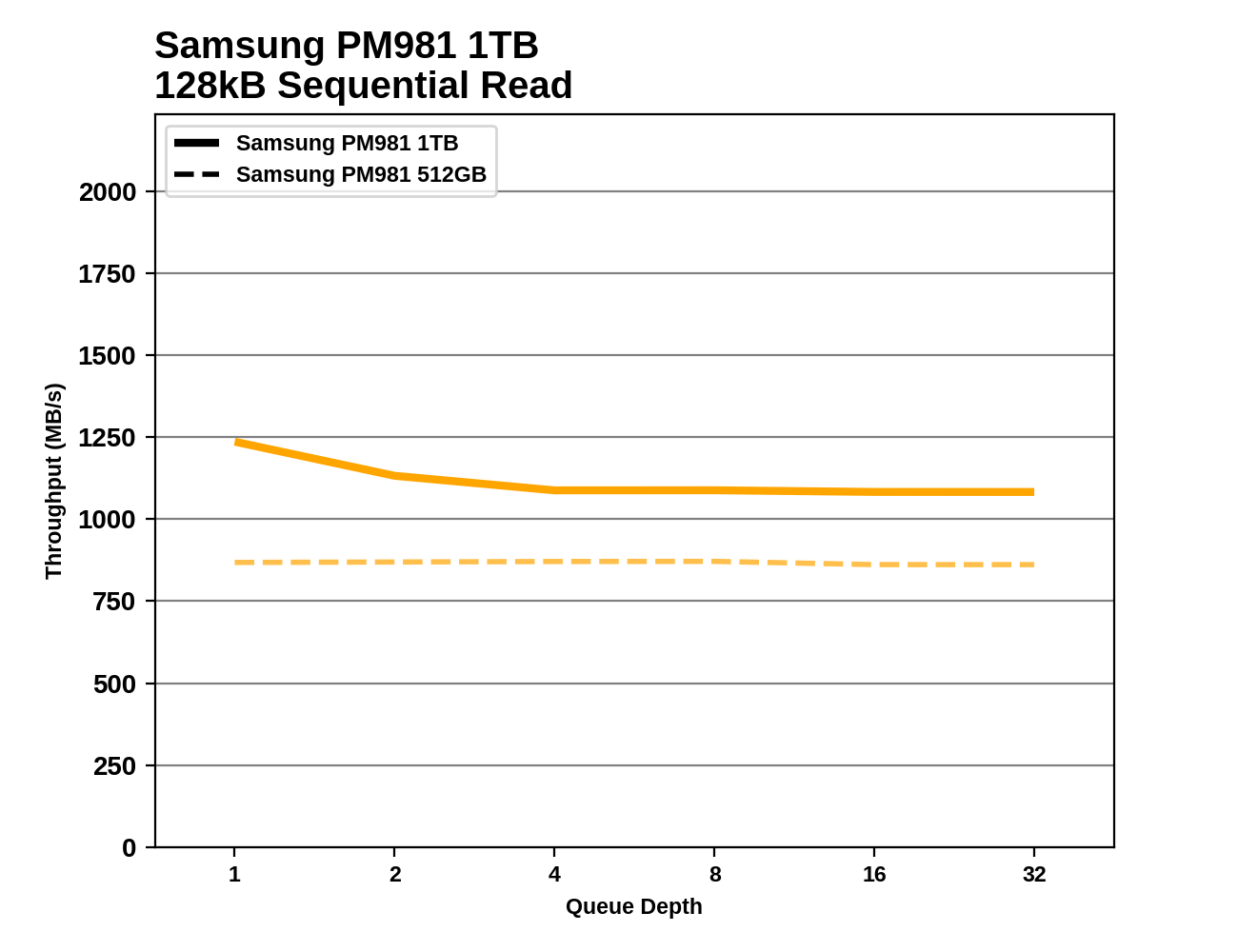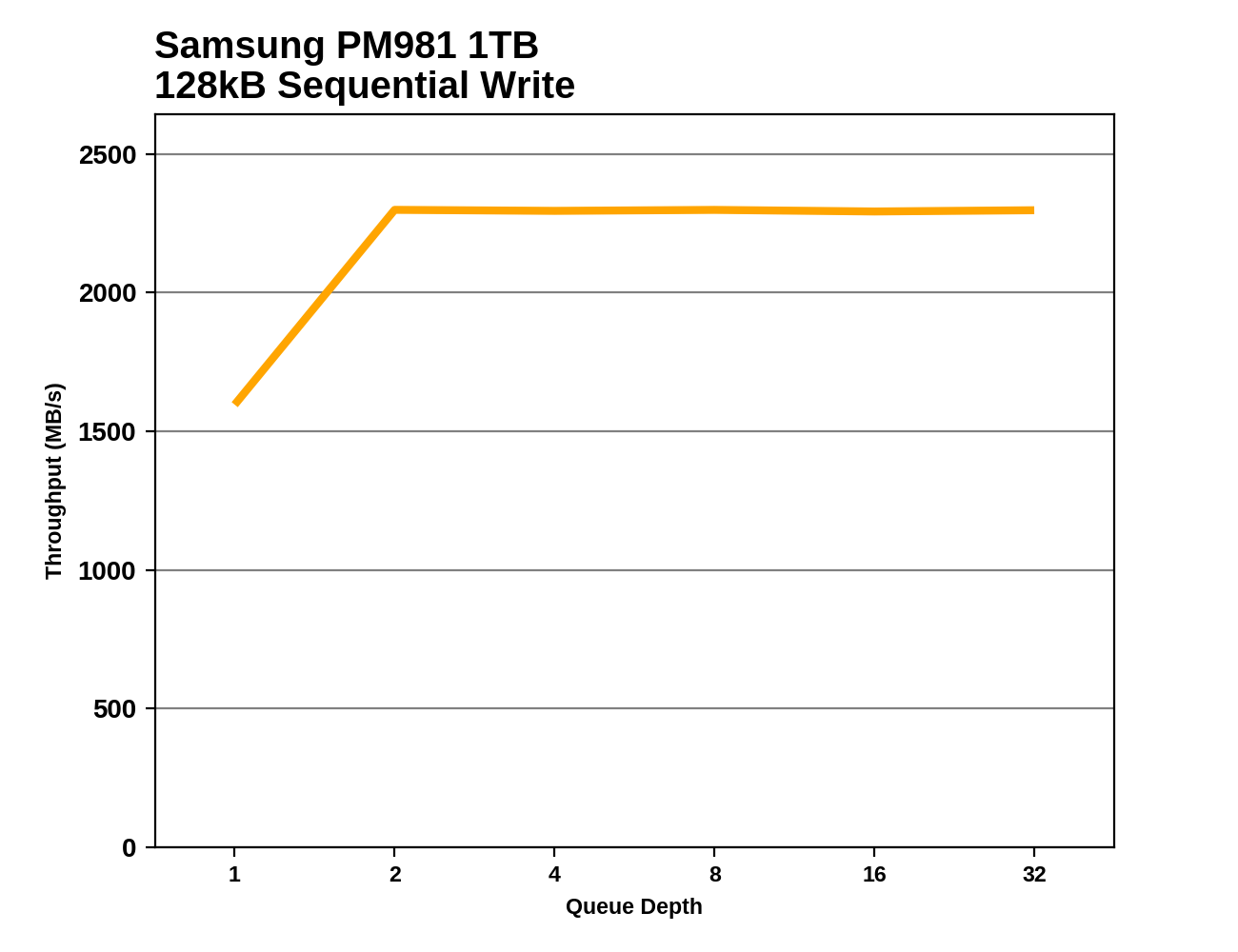The Samsung PM981 SSD Review (512GB, 1TB): Next Generation Controller And 3D NAND
by Billy Tallis on November 30, 2017 9:02 AM ESTSequential Read Performance
Our first test of sequential read performance uses short bursts of 128MB, issued as 128kB operations with no queuing. The test averages performance across eight bursts for a total of 1GB of data transferred from a drive containing 16GB of data. Between each burst the drive is given enough idle time to keep the overall duty cycle at 20%.

The burst sequential read performance of the Samsung PM981 doesn't quite set a new record, but it's pretty close to the top performer and very far ahead of any non-Samsung drive.
Our test of sustained sequential reads uses queue depths from 1 to 32, with the performance and power scores computed as the average of QD1, QD2 and QD4. Each queue depth is tested for up to one minute or 32GB transferred, from a drive containing 64GB of data.

On the longer test with higher queue depths, the best MLC-based drives pull ahead of the PM981 and even the 960 EVO has a slight advantage.
 |
|||||||||
The 1TB PM981 starts out with almost the same performance as the 1TB 960 EVO, but the PM981's performance falls off a bit during the first half of the test while the 960 EVO remains steady. The 512GB PM981 doesn't experience any slowdown, but it is slower than the 1TB model throughout the test.
Sequential Write Performance
Our test of sequential write burst performance is structured identically to the sequential read burst performance test save for the direction of the data transfer. Each burst writes 128MB as 128kB operations issued at QD1, for a total of 1GB of data written to a drive containing 16GB of data.

The PM981s both deliver the same record-setting burst sequential write performance that is a marked improvement over the best of Samsung's last generation, and far ahead of any competing flash-based SSD.
Our test of sustained sequential writes is structured identically to our sustained sequential read test, save for the direction of the data transfers. Queue depths range from 1 to 32 and each queue depth is tested for up to one minute or 32GB, followed by up to one minute of idle time for the drive to cool off and perform garbage collection. The test is confined to a 64GB span of the drive.

On the longer sequential write test, the 512GB PM981 falls behind most of the rest of the Samsung drives but the 1TB model remains on top, ahead of even the 960 PROs.
 |
|||||||||
The 1TB PM981 hits full write speed at QD2 and stays there for the rest of the test, holding on to its lead over the 960 PRO. The 512GB PM981 runs out of SLC write cache early on and its performance bounces around with the garbage collection cycles.










53 Comments
View All Comments
romrunning - Thursday, November 30, 2017 - link
@sleeplessclassics - "Today, even TLC can perform better than MLC/SLC just 2-3 generations ago due to better controllers."Well, the MLC-based 950/960 Pro still is basically beating all of the newer TLC drives. Even in SATA, my Sandisk Extreme Pro still beats all of the TLC drives.
sleeplessclassics - Friday, December 1, 2017 - link
@romrunning, well you should have paid more attention in your high school English class.I am comparing present-gen TLC NAND with SLC/MLC that is two generations old.
Of course, current gen 950/960 Pro MLC NAND with Polaris controllers will beat TLC NAND with Polaris controllers.
I suggest you begin one of the simpler ones like Aesop's fables or maybe those illustrated children books will more your level. And while you are at it, try getting an IQ test as well
romrunning - Friday, December 1, 2017 - link
You mad, bro?! ;)Lighten up a little, and act a little more objectively. Try clarifying the original statement or submitting more information to support your point without resorting to childish insults.
For example, I will submit that you would have had to define "generations" and product lines before you put out generic statements like "Today, even TLC can perform better than MLC/SLC just 2-3 generations ago due to better controllers.". It's also hard to compare since the interface can change (like from SATA to NVMe).
For my example, I will say again that my SATA Sandisk Extreme Pro will still beat newer TLC-based SATA drives from Sandisk. Also, I believe older Intel enterprise controllers (like a DC P3700) can still beat a terrible newer drive like the Intel 600p. There are even specialized drives from several "generations" of product lines ago that can beat some of the "newer" TLC-based drives in the same product line-up.
However, obviously this is changing with NVMe-based drives, although it would harder to find a mfg with two "generations" of controllers on NVMe drives. Plus, we're getting into different tech like 3d XPoint, so TLC likely won't be around anymore a number of years in the future.
I personally am looking forward to retail releases of Samsung's Z-NAND-based drives. It will be very interesting to see how they measure up performance-wise to Optane.
treecrab - Thursday, November 30, 2017 - link
Sequential write numbers are off.1TB drive has fooled you - it has HUGE write buffer. Like 50GB huge. You need to check write speed second by second and on a much larger span (100 GB?)
mapesdhs - Thursday, November 30, 2017 - link
Toms posted a review and pointed this out with their sustained tests.Drumsticks - Thursday, November 30, 2017 - link
It feels like we haven't seen new high end drives from Samsung in a while (not that they're really heavily in need given the performance on tap already). It'll be nice to see another round of products coming out of them. Thanks for the review!Side note: Would it be possible to, in future SSD reviews, add those buttons that change the graphs based on capacity for the different storage metrics? Perhaps a button for "All SSDs," "250GB," "500GB," "1TB+" or something. Performance can vary wildly across capacities, and it would be a nice way to sort through all of the 500GB class drives that you've reviewed for example. The only outlier would be Optane since it isn't quite as dominated by the amount of parallel dies you can add.
mapesdhs - Thursday, November 30, 2017 - link
Good idea; it's bizarre how sometimes the 960 EVO looks terrible compared to the 1TB version, and sometimes the other way round. Steady state is particularly bad, it's why I stuck with hunting for 950 Pros instead, which also have their own boot ROM and thus work ok on older mbds.Kastriot - Thursday, November 30, 2017 - link
200$ for 512GB i have intel 530 480GB which i bought on ebay for 80 euros 3 years ago and still working great so ssd prices are insane like memory+gpu+intel cpu-s prices together, dark times for PC desktop owners unless you have dosh :)mapesdhs - Thursday, November 30, 2017 - link
GN has commented on this quite a lot recently, it is indeed a sucky time to build a new PC. Hence why I make the most of used parts (or new ones via normal auction) until the need for something better really is paramount. Bagged another 840 Pro 256GB recently for a good price; pity old models like this are not included in newer product reviews, I bet they'd put newer products to shame. For a while the old Vector was retained in newer reviews, but then it vanished, probably because it just looked too good compared to the latest tech. The same likely applies to the Neutron GTX, Vertex4 and various other models, at least in the SATA world anyway. If one can though, it's better to go NVMe, the SM951 and SM961 are rather good.bcronce - Thursday, November 30, 2017 - link
It looked mostly on par until the "mixed" results. Nice!